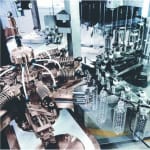 Bottling lines in the beverage industry fill entire buildings. Faults in individual units can therefore affect the efficiency of the overall line. Manufacturers of bottling and packaging lines know the challenges and now offer space-saving solutions which also operate more cost efficiently.
Bottling lines in the beverage industry fill entire buildings. Faults in individual units can therefore affect the efficiency of the overall line. Manufacturers of bottling and packaging lines know the challenges and now offer space-saving solutions which also operate more cost efficiently.The market share of bottled mineral water in the western industrialised countries is growing steadily despite the good quality of drinking water available directly from the tap. Beer consumption is stagnating even in the major beer-drinking nations such as the Czech Republic, Germany, the UK and the Benelux countries. At the same time, however, new markets with great potential and huge growth rates like China, India and the CIS states are opening up for the manufacturers of bottling systems.
Both mineral water and beer are very demanding products which are increasingly being packaged in PET bottles in large areas of the world. According to the London-based market research company Euromonitor, production of PET containers will rise by seven percent a year to reach 350 billion bottles per year in 2009 (2006: 288 billion). That makes it all the more important to produce PET containers as cost-efficiently as possible.
Ahead of interpack 2008 (Düsseldorf, 24 to 30 April 2008), leading equipment manufacturers have integrated stretch blow moulding machines with filling lines in response to the wish of many bottlers to further expand their capacities using as little space as possible. PET bottles have become a huge success in the field of disposable containers. Another trend in PET bottles is to reduce weight and thereby save material.

Cutting out the middle man
An integrated system to blow and fill PET bottles is a cost-effective solution. Directly linking the stretch blow moulding machine with the filler offers numerous advantages. Although a bottle conveyor can serve as a buffer and support cooling of the bottles, transport problems and interruptions are often caused by jammed bottles, especially in complex conveying systems with numerous curves and/or height differences.
Frequently, this makes it necessary to halt production of the stretch blow moulding machine, thus compromising its efficiency and lowering the output of the entire line. An integrated system eliminates this source of problems. Here, the stretch blow moulding machine and the filler are the only factors determining the system`s overall efficiency. In case of irregularities, the filler communicates directly with the connected blow moulder.
The control system immediately decouples the two machines and empties the stretch blow moulding unit. Preforms which have already been loaded run through the heating system and finished bottles are ejected on a conveyor belt.
Bottles for carbonated beverages, which leave the stretch blow moulding machine at a temperature of about 75 degrees Celsius, have to be cooled down to roughly 55 degrees Celsius. In integrated systems, a rinser can be included to reduce the temperature with an internal rinse. Even without a rinser, the desired result can be achieved by using a specially adapted base cooling system in the bottle transfer zone.
Even lighter bottles
Lightweighting is another trend to which preform and equipment manufacturers are turning their attention. By reducing material thickness, especially at the carrier ring, considerable cost savings can be achieved, for example, in material purchasing. Another concept is based on using the flexibility and shape memory of the plastic (memory effect).



